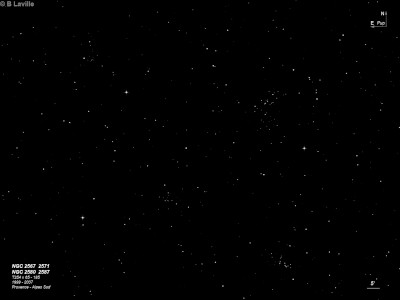
William Herschel discovered NGC 2571 = H VI-39 = h502 on 3 Mar 1793 (sweep 1032) and noted "a cluster of large stars, considerably rich, iR, above 15' diameter." John Herschel logged it on 6 Jan 1831 (sweep 316) as "a v loose straggling but p rich cl which fills the field, st 9m and under; vl comp middle. Some large st preced it."
300/350mm - 13.1" (3/24/84): 18 stars mag 8.8-12 in 10' diameter. Includes a wide bright pair (mag 8.8 SAO 175580 and 8.9 SAO 175577) at 1' separation oriented NW-SE near the center. This cluster is larger and contains brighter stars than NGC 2587 one degree ENE. Also NGC 2580 lies 47' SE and NGC 2567 54' S.
600/800mm - 24" (3/21/20): at 200x; very interesting cluster with ~30 stars in the core of the cluster, including two 9th mag stars, HD 70058 and 70078, oriented NW-SE and a large number of stars 10th-11th magnitude. The "core" stars are pretty isolated by a wide, mostly empty ring with only much fainter stars. At a radius of 4' from the center is a prominent string of stars to the NW (oriented SW-NE) and an extensive group of stars to the south that may also be part of the cluster. Including the large group out to 13' diameter increases the total to 100-120 stars (though a large number are unrelated stars), but it appears too loose to be distinctive at this size. This region of the Milky Way is rich in bright and faint stars: a 7th mag star (HD 69817) is 17' WNW and mag 6-7th mag stars are 20' SW and 20' NE.
Notes by Steve Gottlieb